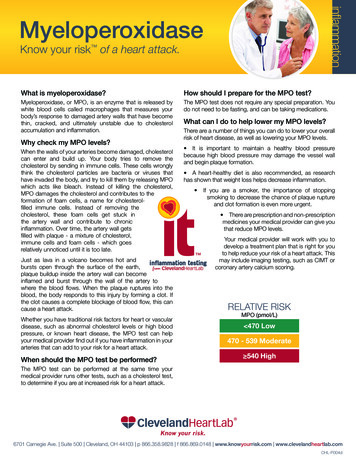
Transcription
MyeloperoxidaseKnow your risk of a heart attack.What is myeloperoxidase?Myeloperoxidase, or MPO, is an enzyme that is released bywhite blood cells called macrophages that measures yourbody’s response to damaged artery walls that have becomethin, cracked, and ultimately unstable due to cholesterolaccumulation and inflammation.Why check my MPO levels?When the walls of your arteries become damaged, cholesterolcan enter and build up. Your body tries to remove thecholesterol by sending in immune cells. These cells wronglythink the cholesterol particles are bacteria or viruses thathave invaded the body, and try to kill them by releasing MPOwhich acts like bleach. Instead of killing the cholesterol,MPO damages the cholesterol and contributes to theformation of foam cells, a name for cholesterolfilled immune cells. Instead of removing thecholesterol, these foam cells get stuck inthe artery wall and contribute to chronicinflammation. Over time, the artery wall getsfilled with plaque - a mixture of cholesterol,immune cells and foam cells - which goesrelatively unnoticed until it is too late.Just as lava in a volcano becomes hot andbursts open through the surface of the earth,plaque buildup inside the artery wall can becomeinflamed and burst through the wall of the artery towhere the blood flows. When the plaque ruptures into theblood, the body responds to this injury by forming a clot. Ifthe clot causes a complete blockage of blood flow, this cancause a heart attack.Whether you have traditional risk factors for heart or vasculardisease, such as abnormal cholesterol levels or high bloodpressure, or known heart disease, the MPO test can helpyour medical provider find out if you have inflammation in yourarteries that can add to your risk for a heart attack.When should the MPO test be performed?How should I prepare for the MPO test?The MPO test does not require any special preparation. Youdo not need to be fasting, and can be taking medications.What can I do to help lower my MPO levels?There are a number of things you can do to lower your overallrisk of heart disease, as well as lowering your MPO levels. It is important to maintain a healthy blood pressurebecause high blood pressure may damage the vessel walland begin plaque formation. A heart-healthy diet is also recommended, as researchhas shown that weight loss helps decrease inflammation. If you are a smoker, the importance of stoppingsmoking to decrease the chance of plaque ruptureand clot formation is even more urgent. There are prescription and non-prescriptionmedicines your medical provider can give youthat reduce MPO levels.Your medical provider will work with you todevelop a treatment plan that is right for youto help reduce your risk of a heart attack. Thismay include imaging testing, such as CIMT orcoronary artery calcium scoring.RELATIVE RISKMPO (pmol/L) 470 Low470 - 539 Moderate 540 HighThe MPO test can be performed at the same time yourmedical provider runs other tests, such as a cholesterol test,to determine if you are at increased risk for a heart attack.6701 Carnegie Ave. Suite 500 Cleveland, OH 44103 p 866.358.9828 f 866.869.0148 www.knowyourrisk.com www.clevelandheartlab.comCHL-P004d
Lp-PLA2Know your risk for a heart attack or stroke.What is the Lp-PLA2 Test?The Lp-PLA2 Test measures the amount of Lp-PLA2 in thebloodstream. Lp-PLA2 is an enzyme that can assess theamount of inflammation in your arteries due to a build-up ofcholesterol.Why should I get the Lp-PLA2 Test?The Lp-PLA2 Test can help assess your risk for heartdisease or stroke. When LDL cholesterol (the carrier of “bad”cholesterol) gets into your artery wall, the body tries to getrid of it by making Lp-PLA2. Unfortunately, the actions ofLp-PLA2 contribute to increased inflammation and increasedcholesterol accumulation in the artery wall, forming what iscalled plaque. Inflammation can also make the cap coveringthe plaque thinner, which makes it more likely torupture. The body responds to the rupture byforming a blood clot, which can block the flowof blood. If the blood flowing to the heart isblocked, it may cause a heart attack, whileblocked blood flow to the brain may causea stroke.In short, the Lp-PLA2 Test can help yourmedical provider better understand the healthof your arteries and determine if you are activelygrowing plaque that is at risk for rupturing anddeveloping a heart attack or stroke.Traditionally, the risk of having a stroke is associated withmany factors including high blood pressure. Although highblood pressure is known to increase stroke risk, having highblood pressure and a high Lp-PLA2 Test result can put you ata much higher risk for stroke. But, it’s important to rememberthat even if your blood pressure is controlled, a high Lp-PLA2Test result alone still puts you at risk for a stroke.When should the Lp-PLA2 Test be performed?The Lp-PLA2 Test can be performed at the same time yourmedical provider runs other tests, such as a cholesterol test,to determine if you are at increased risk for heart disease orstroke. The Lp-PLA2 Test is recommended if you have two ormore risk factors for heart disease, such as high cholesterolor obesity.How should I prepare for the Lp-PLA2 Test?The Lp-PLA2 Test does not require any special preparation.You do not need to be fasting, and can be taking medications.What can I do to help lower my Lp-PLA2 levels?There are a number of things you can do to lower your overallrisk of heart disease, as well as lowering your Lp-PLA2 levels. Adopting a heart-healthy diet can help to lower yourLp-PLA2 levels. Eat more vegetables, fruits, and whole grainfoods and reduce the amount of fatty foods you eat. Exercise can also help to reduce your Lp-PLA2 levels. If you smoke, quit. It is not easy but there are programs andstrategies (including over-the-counter and prescriptionmedications) that can improve your chance ofsuccess. Talk with your medical provider to findwhat works best for you. See your dentist. Periodontal diseasemay elevate Lp-PLA2. There are prescription and non-prescription medicines, as well as supplements, yourmedical provider can give you that reduceLp-PLA2 levels.Your medical provider will work with you todevelop a treatment plan that is right for you to helpreduce your risk of heart attack and stroke.RELATIVE RISKLp-PLA2 (ng/mL) 200 Low 200 High6701 Carnegie Ave. Suite 500 Cleveland, OH 44103 p 866.358.9828 f 866.869.0148 www.knowyourrisk.com www.clevelandheartlab.comCHL-P002d
hsCRPKnow your risk for chronic inflammation.What is hsCRP?C-reactive protein (CRP) is produced by the liver wheninflammation is present somewhere in your body. Traditionally,the CRP test has been used to identify risk for infection orchronic inflammatory conditions. Now, there is a newer testavailable called high-sensitivity CRP, or hsCRP, that measuressmaller amounts of CRP in the blood.Why should I get my hsCRP levels checked?Most of the time, you can tell if you have inflammation. Forexample, if you cut your finger, you may see redness andswelling, and feel pain. This is called acute inflammation,or short-term inflammation. Other times, inflammation inyour body may not be so obvious. This type of inflammationmay be present for a long period of time without anysymptoms. This is called chronic inflammation, orlong-term inflammation.Recently, it has been shown by researchersthat chronic inflammation may occur within thearteries of the heart, where it may play a rolein the development and progression of heartdisease, acting as a “silent killer”. Standardheart health tests, such as cholesterol tests,miss this chronic inflammation. The good newsis that chronic inflammation can be monitoredby measuring hsCRP levels in your blood.Researchers have shown that high hsCRP levels canindicate heart attack and stroke risk, even in apparentlyhealthy individuals. High hsCRP levels are also a risk factorfor people who do not have other risk factors that medicalpractitioners commonly look for such as high cholesterolor high blood pressure. For people who have had a heartattack, elevated hsCRP levels may indicate if they are at riskfor another heart attack or an ischemic stroke.When should my hsCRP levels be checked?Your hsCRP level can be checked at the same time yourmedical provider runs other tests, such as a cholesterol test,to determine if you are at increased risk for a heart attack orstroke. You may be a good candidate for hsCRP testing ifyou are at moderate risk of vascular disease, or have severalother risk factors such as high cholesterol or a family historyof heart disease.How should I prepare for the hsCRP test?The hsCRP test does not require any special preparation. Youdo not need to be fasting, and can be taking medications.Make sure you don’t have a cold, the flu or a dental infectionwhen being checked as hsCRP levels will go up when you’resick. Instead, you should wait until you feel better before youare checked.What can I do to help lower my hsCRP levels? Lifestyle changes, such as exercising more, eating moreheart-healthy high fiber foods such as fruits/vegetables andwhole grains or following a Mediterranean diet, can helpto lower hsCRP levels. Quitting smoking helps reduce the amountof general inflammation in your body. Taking good care of your teeth can alsohelp lower hsCRP and reduce your risk ofheart disease. There are prescription and non-prescriptionmedications that also can lower hsCRP.It is important for you to work together with yourmedical provider to come up with a plan that is rightfor you.RELATIVE RISKhsCRP (mg/L) 1.0 Low1.0-3.0 Moderate 3.0 High6701 Carnegie Ave. Suite 500 Cleveland, OH 44103 p 866.358.9828 f 866.869.0148 www.knowyourrisk.com www.clevelandheartlab.comCHL-P001c
Urinary MicroalbuminKnow your risk for endothelial dysfunction.What do my kidneys do?Your kidneys have an important role in keeping you alive andwell. Their main function is to get rid of waste and extra waterfrom your body. This is done by the endothelium, or the thin layerof cells that line the blood vessels in the kidney, which act like acoffee filter. The kidney endothelium filters your blood to get ridof waste by making urine. Your kidneys also do other importantthings, such as help control your blood pressure.What is urinary microalbumin?Albumin is a protein that is normally found in your blood and notnormally found in your urine. The urinary microalbumin test isable to measure very small amounts (micro-) of albumin that canleak into the urine.What causes increased urinarymicroalbumin?If albumin is in the urine, even in small amounts,then you may have kidney damage. You canthink of kidney damage as a ripped coffee filterwhich allows coffee grounds into your coffee.This damage may be caused by high bloodpressure or high blood sugar levels, both ofwhich can cause damage to the endotheliumof the kidney. Albumin can sneak through thisdamage in the endothelium and end up in the urine,where it can be measured.Why should I get my urinary microalbuminlevels checked?If your medical provider finds out that albumin is leaking intoyour urine, this may be a sign that there is damage to othertissues in your body including your arteries. The things that aredamaging the endothelium in your kidneys, such as having highblood pressure or high blood sugar, are probably also damagingthe endothelium in your arteries. When the endothelium in thearteries becomes damaged, cholesterol can accumulate there,setting off a chain of events that may result in the developmentof plaque. Increased levels of urinary microalbumin may alsoidentify the presence of diabetes or heart disease.When should my urinary microalbumin levelsbe checked?Your urinary microalbumin levels should be checked at thesame time your medical provider runs other tests, such asa cholesterol test. If your level is high, your medical providermay want to repeat the test. High urinary microalbuminlevels may be seen in pregnancy, following exercise, or in peoplewith high blood sugar levels, fever or urinary tract infections.How should I prepare for the urinarymicroalbumin test?The urinary microalbumin test does not require any specialpreparation. You do not need to be fasting, and can be takingmedications. It is best if you have the urinary microalbumintest done in the morning.What can I do to help lower myurinary microalbumin levels?Two major factors that contribute to high urinarymicroalbumin levels are high blood pressureand high blood sugar levels. Therefore, it isimportant that you work with your medicalprovider to develop a plan to lower these. Lifestyle changes, including increasing theamount of fruits, vegetables, and whole grainproducts and reducing the amount of salty or sugaryfoods you eat may help to reduce your blood pressure andblood sugar. Exercising regularly can also help you regulate your bloodpressure and blood sugar. There are medications which your medical provider canprescribe if lifestyle changes are not working well enough for you.Talk with your medical provider to develop a plan that works thebest for you.RELATIVE RISKUrinary Microalbumin/Creatinine (mg/g)WomenMenLow 7.5 3.9High 7.5 3.96701 Carnegie Ave. Suite 500 Cleveland, OH 44103 p 866.358.9828 f 866.869.0148 www.knowyourrisk.com www.clevelandheartlab.comCHL-P003d
Oxidized LDLKnow your risk for metabolic syndrome.Metabolic syndrome consists of various risk factors thatincrease your chance of developing diabetes or vasculardisease. Metabolic syndrome is characterized by having atleast 3 of the following risk factors: a large waistline, hightriglyceride levels, low HDL cholesterol (the “good” cholesterol)levels, high blood pressure or high blood glucose levels. Inthe US, approximately 34% of adults meet the criteria formetabolic syndrome. Even more alarming is the increasingpresence of metabolic syndrome in children due to obesity.Unfortunately, by the time metabolic syndrome is diagnosed,your blood vessels and heart are already damaged.Researchers have recently found that measuring oxidizedLDL can predict your risk of developing metabolic syndrome.What is oxidized LDL?Oxidized LDL is LDL cholesterol (the “bad”cholesterol) that has been modified by oxidation.Oxidized LDL triggers inflammation leading tothe formation of plaque in the arteries, alsoknown as atherosclerosis. Oxidized LDL mayalso play a role in increasing the amount oftriglycerides the body produces, as well asincreasing the amount of fat deposited bythe body. In turn, fat tissue can enhance theoxidation of LDL, creating a vicious cycle.Why should I get my oxidized LDLlevels tested?Researchers have found that individuals with high levels ofoxidized LDL are 4x more likely to develop metabolic syndromeup to five years following testing. In particular, increasedoxidized LDL levels were associated with abdominal obesityand high triglyceride levels, as well as high blood glucose.The oxidized LDL test can also help your medical providerdecide if you may be at a higher risk for heart attack or heartdisease than by looking at traditional risk factors alone.Oxidized LDL may be twice as good at helping your medicalprovider know your risk for heart disease as any one of thetraditional risk factors.When should I get tested for oxidized LDL?Your oxidized LDL levels should be tested when you get yourstandard cholesterol test. Your medical provider may orderoxidized LDL if you are at low or intermediate risk of metabolicsyndrome or cardiovascular disease due to lifestyle risks.How should I prepare for the oxidized LDL test?There are no preparations necessary. The oxidized LDL testdoes not require you to fast, and you can continue to takeyour medications.What can I do to help lower my oxidizedLDL levels? Lifestyle changes are the best option to help lower youroxidized LDL levels. If you smoke, ask your medical providerto help you quit. It is not easy but there areprograms and strategies (including over-thecounter and prescription medications) thatcan improve your chance of success. Adjust your diet to include foods low insaturated fat and those with zero trans-fat.Fruits and vegetables are also great optionsas they contain anti-oxidants. Talk with your medical provider about over-thecounter supplements containing anti-oxidants. Increase your amount of physical activity as approved byyour medical provider.RELATIVE RISKOxLDL (U/L) 60 Low60-69 Moderate 70 High6701 Carnegie Ave. Suite 500 Cleveland, OH 44103 p 866.358.9828 f 866.869.0148 www.knowyourrisk.com www.clevelandheartlab.comCHL-P005d
F2-IsoprostanesKnow your risk for oxidative stress.Why is lifestyle so important?Why check my F2-IsoPs?Eating right and getting enough exercise are important factorsfor your health today as well as in the future. Bad habits, such asbypassing a home-cooked meal to grab fast food or spendingyour days on the couch watching TV rather than taking a 20minute walk, can contribute to the onset of various chronicdiseases such as diabetes, heart disease, and cancer.F2-IsoPs can cause blood vessels to constrict, which may raiseyour blood pressure, and promote blood clotting resulting ina heart attack or stroke. In support of this, F2-IsoPs may beelevated at the earliest stages of plaque development in yourarteries. Research has shown that people with high levels ofF2-IsoPs are 30x more likely to develop heart disease1.Poor lifestyle choices not only contribute to how you feel mentallybut how your body functions physically. As part of everyday life,our bodies produce some potentially harmful molecules calledfree radicals. These free radicals cause damage to parts of thecells in your body, such as DNA and lipids, by a process calledoxidation. Most of the time, your body is able to combat damageto its tissues through the use of antioxidants. However,lifestyle choices may increase the amount of oxidation inthe body and overwhelm its antioxidant capabilities.This creates a state of imbalance often referred toas oxidative stress which, in turn, increases thelikelihood of tissue damage and the potentialfor chronic disease.When should my F2-IsoPs levels be checked?One chronic disease which has , the build-up of plaque in thearteries. Atherosclerosis can lead to heart disease,heart attacks or strokes. Therefore, knowing howmuch oxidative stress your body is under can helpyou keep your heart and entire vascular system healthy. Yourphysician now has the ability to assess the amount of oxidationin your body by using a non-invasive urine test to measure yourF2-Isoprostanes (F2-IsoPs) levels.What are F2-IsoPs?F2-IsoPs are compounds formed from arachidonic acid.Arachidonic acid is required by your body to make muscles andfor basic functioning. Your body can make arachidonic acid onits own, or can get it from the foods you eat, such as red meator egg yolks. As with many things, having too much or too littlearachidonic acid can be harmful to the body. Having too mucharachidonic acid can increase the production of F2-IsoPs whichcan damage the body’s tissues and therefore contributes to theonset of chronic disease.Your F2-IsoPs levels can be checked at the same time yourmedical provider runs other tests, such as a cholesterol test,to determine if you are at increased risk for developing vasculardisease.How should I prepare for the F2-IsoPs test?The F2-IsoPs test does not require any specialpreparation. You do not need to be fasting, andcan be taking medications.What can I do to help lower myF2-IsoPs levels?Because F2-IsoPs are known as “lifestyle”markers, their levels are affected by lifestylechoices you make, such as what you eat andhow much you exercise. Therefore, you canmake changes in your daily life which can lower yourF2-IsoPs to safe levels. Reducing the amount of red meat and increasing theamount of fruit and vegetables you eat can help lower yourF2-IsoPs levels. Adding one fish meal a week as part of a low-fatdiet may also lower F2-IsoPs levels. Your F2-IsoP levels may also be lowered by increasing theamount you exercise. If you smoke, you should consider stopping as smoking alsoincreases F2-IsoPs levels.1. Schwedhelm E et al. Urinary 8-iso-prostaglandin F2a as a risk marker in patients with coronaryheart disease: A matched case-control study. Circulation. 2004; 109: 843-848.RELATIVE RISKF2-IsoPs (ng/mg) 0.86 Low 0.86 High6701 Carnegie Ave. Suite 500 Cleveland, OH 44103 p 866.358.9828 f 866.869.0148 www.knowyourrisk.com www.clevelandheartlab.comCHL-P006c
ADMA/SDMAKnow your risk for endothelial dysfunction.What is the endothelium and why is itimportant?When should my ADMA/SDMA levels bechecked?The endothelium is a thin layer of cells lining the inside of yourblood vessels. These cells are in constant contact with the bloodsupply and, therefore, play an integral role in immunity, bloodclotting and maintenance of blood pressure. When your endothelium isdamaged, it may signify that you are at increased risk of havingcardiovascular disease or renal failure.Your ADMA and SDMA levels should be checked if you have a poordiet/lifestyle, elevated LDL cholesterol, high blood sugar, high bloodpressure, or if you are a smoker.What are ADMA and SDMA?ADMA (asymmetric dimethylarginine) and SDMA (symmetricdimethylarginine) are compounds made in your body as proteins aredegraded, or broken down. ADMA and SDMA reduce yourbody’s ability to produce nitric oxide, a molecule thathelps maintain a healthy endothelium. Therefore,elevated levels of ADMA and SDMA mayidentify reduced nitric oxide production andendothelial dysfunction, or damage.What causes increasedADMA/SDMA levels?Your ADMA and SDMA levels mayincrease if you have a poor diet/lifestyle,elevated LDL cholesterol, high bloodsugar, high blood pressure, or if you area smoker. These are all risk factors thatcan damage the delicate endothelial cellsthat protect your vasculature.Why should I check my ADMA/SDMA levels?You should check your ADMA/SDMA levels todetermine if you have a healthy endothelium. ADMA can tell you if your risk factors may be contributingto endothelial damage and increasing your likelihood forcardiovascular disease. SDMA can tell you if your risk factors may be contributing to anincreased likelihood for kidney damage or, in some cases, kidneyfailure.How do I prepare for the ADMA/SDMA test?It is recommended, but not required, that you fast overnight beforeyour sample is collected.What can I do to lower my ADMA/SDMAlevels?Focusing on the health of your endothelium may helpto lower ADMA and SDMA levels. This may beaccomplished through: Lifestyle changes, including a balanceddiet that is low in fat and incorporates morefruits and vegetables. You should limityour intake of sweet and salty foods. Maintaining an active lifestyle withregular exercise, maintaining a healthyweight, lowering blood pressure anddecreasing blood LDL cholesterol levels. Medications your provider mayprescribe to achieve a healthy bloodpressure or normalize blood cholesteroland blood sugar levels.It is important that you talk with your medicalprovider to develop a plan that works for you.RELATIVE RISKREFERENCE RANGEADMA (ng/mL)SDMA (ng/mL) 100 Low73 - 135 Low100 - 123 Moderate 135 High 123 HighDisclaimer: The information provided here is for educational purposes only. All testing results should be reviewed and interpreted by your treating physician.6701 Carnegie Ave. Suite 500 Cleveland, OH 44103 p 866.358.9828 f 866.869.0148 www.knowyourrisk.com www.clevelandheartlab.comCHL-P040
Adopting a heart-healthy diet can help to lower your Lp-PLA 2 levels. Eat more vegetables, fruits, and whole grain foods and reduce the amount of fatty foods you eat. Exercise can also help to reduce your Lp-PLA 2 levels. If you smoke, quit. It is not easy but there are pr









